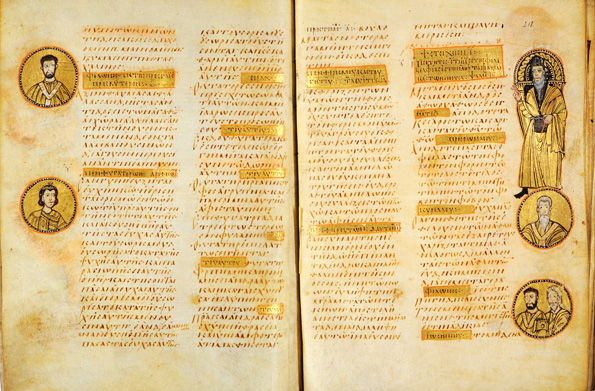Sacra Parallela, folios 207v–208r, 9th century. Black, red, and brown ink on parchment; 394 folios. Bibliothèque Nationale de France, Paris (Grec 923). This manuscript includes quotations attributed to John of Damascus, as well as his full-length portrait (folio 208v, right margin).
Few figures embody the transitional spirit of the seventh and eighth centuries A.D. as fully as does John of Damascus. His life gives a sense of the multicultural milieu of the early Islamic city and its diverse population of Christians and Muslims, Arabs and Greeks. Born Yuhanna ibn Mansur ibn Sarjun, he was part of an elite Christian family. His grandfather likely served as Byzantine governor and then Umayyad court official; John himself may have served as a functionary for the early caliphs, which is understandable in that he would have been fully fluent in both Arabic and Greek.
John of Damascus was a prolific writer, and he used his formidable intellect to defend the worship of images during the period of Orthodox iconoclasm and mounting Islamic prohibitions against images. His most famous work is Three Treatises on the Divine Images. The first apology, or defense, goes toe to toe against iconoclasts who accuse those praying through icons of idolatry. After expounding the differences between correct and incorrect worship, John attempts to define the nature of images. Images can render the invisible visible; they can recall past events; they visualize what is imagined; they reflect ideals of what should be. The concepts feel very contemporary, for in many ways the same questions surround our own expectations of art. For John's theological purposes, the validity of images boils down to his belief that Christ and mankind itself are kinds of images of God, material manifestations of a spiritual ideal.
John died in Mar Saba monastery outside Jerusalem in 749. Because of his support for images, he remains a popular saint among churches in which icons play key liturgical roles. He is frequently represented in Orthodox icons, and is revered for his defense of icons foundational to the expression of their faith.
